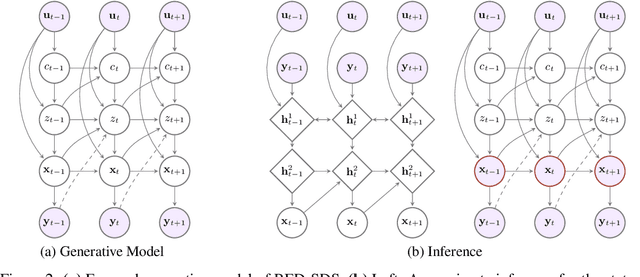Ali Caner Turkmen
Deep Explicit Duration Switching Models for Time Series
Oct 26, 2021



Abstract:Many complex time series can be effectively subdivided into distinct regimes that exhibit persistent dynamics. Discovering the switching behavior and the statistical patterns in these regimes is important for understanding the underlying dynamical system. We propose the Recurrent Explicit Duration Switching Dynamical System (RED-SDS), a flexible model that is capable of identifying both state- and time-dependent switching dynamics. State-dependent switching is enabled by a recurrent state-to-switch connection and an explicit duration count variable is used to improve the time-dependent switching behavior. We demonstrate how to perform efficient inference using a hybrid algorithm that approximates the posterior of the continuous states via an inference network and performs exact inference for the discrete switches and counts. The model is trained by maximizing a Monte Carlo lower bound of the marginal log-likelihood that can be computed efficiently as a byproduct of the inference routine. Empirical results on multiple datasets demonstrate that RED-SDS achieves considerable improvement in time series segmentation and competitive forecasting performance against the state of the art.
Intermittent Demand Forecasting with Renewal Processes
Oct 04, 2020



Abstract:Intermittency is a common and challenging problem in demand forecasting. We introduce a new, unified framework for building intermittent demand forecasting models, which incorporates and allows to generalize existing methods in several directions. Our framework is based on extensions of well-established model-based methods to discrete-time renewal processes, which can parsimoniously account for patterns such as aging, clustering and quasi-periodicity in demand arrivals. The connection to discrete-time renewal processes allows not only for a principled extension of Croston-type models, but also for an natural inclusion of neural network based models---by replacing exponential smoothing with a recurrent neural network. We also demonstrate that modeling continuous-time demand arrivals, i.e., with a temporal point process, is possible via a trivial extension of our framework. This leads to more flexible modeling in scenarios where data of individual purchase orders are directly available with granular timestamps. Complementing this theoretical advancement, we demonstrate the efficacy of our framework for forecasting practice via an extensive empirical study on standard intermittent demand data sets, in which we report predictive accuracy in a variety of scenarios that compares favorably to the state of the art.
Intermittent Demand Forecasting with Deep Renewal Processes
Nov 23, 2019


Abstract:Intermittent demand, where demand occurrences appear sporadically in time, is a common and challenging problem in forecasting. In this paper, we first make the connections between renewal processes, and a collection of current models used for intermittent demand forecasting. We then develop a set of models that benefit from recurrent neural networks to parameterize conditional interdemand time and size distributions, building on the latest paradigm in "deep" temporal point processes. We present favorable empirical findings on discrete and continuous time intermittent demand data, validating the practical value of our approach.
 Add to Chrome
Add to Chrome Add to Firefox
Add to Firefox Add to Edge
Add to Edge